| Queensland Railways 1400 class | |||||||||||||||||||||
|---|---|---|---|---|---|---|---|---|---|---|---|---|---|---|---|---|---|---|---|---|---|
 | |||||||||||||||||||||
| |||||||||||||||||||||
| |||||||||||||||||||||
| |||||||||||||||||||||
| |||||||||||||||||||||
The 1400 class was a class of diesel locomotive built by Clyde Engineering, Granville for Queensland Railways between 1955 and 1957.
| Queensland Railways 1400 class | |||||||||||||||||||||
|---|---|---|---|---|---|---|---|---|---|---|---|---|---|---|---|---|---|---|---|---|---|
 | |||||||||||||||||||||
| |||||||||||||||||||||
| |||||||||||||||||||||
| |||||||||||||||||||||
| |||||||||||||||||||||
The 1400 class was a class of diesel locomotive built by Clyde Engineering, Granville for Queensland Railways between 1955 and 1957.
In 1955, Clyde Engineering demonstrated an Electro-Motive Diesel G12 locomotive to Queensland Railways who purchased it along with two other demonstrators under construction, and also placed an order for a further 10. The first three were initially numbered 1230-1232, before being reclassified as the 1400 class. [1] When built, they were tested on standard gauge with Bo-Bo bogies, and received their A1A-A1A bogies upon arrival in Queensland. The demonstrators differ from the production series in placement of the number boxes and marker lights on the ends of the unit.
They are similar in appearance to the NZR DA class, first-series Victorian Railways T class and the Kowloon-Canton Railway Class 51 (later the CFCLA TL class), and mainly operated in South East Queensland. [2] [3] The first was withdrawn in December 1986.
Two have been preserved: [4]
The 1450 class is a Co-Co version of the G12, lengthened on both ends to accommodate the bogies.
Brush Traction was a manufacturer and maintainer of railway locomotives in Loughborough, England whose operations have now been merged into the Wabtec company's Doncaster UK operations.
The AAR wheel arrangement system is a method of classifying locomotive wheel arrangements that was developed by the Association of American Railroads. Essentially a simplification of the European UIC classification, it is widely used in North America to describe diesel and electric locomotives. It is not used for steam locomotives, which use the Whyte notation instead.

The EMD FP7 is a 1,500 horsepower (1,100 kW), B-B dual-service passenger and freight-hauling diesel locomotive produced between June 1949 and December 1953 by General Motors' Electro-Motive Division and General Motors Diesel. Final assembly was at GM-EMD's La Grange, Illinois plant, excepting locomotives destined for Canada, in which case final assembly was at GMD's plant in London, Ontario. The FP7 was essentially EMD's F7A locomotive extended by four feet to give greater water capacity for the steam generator for heating passenger trains.

"Bulldog nose" is the nickname given, due to their appearance, to several cab-unit diesel-electric locomotives manufactured by GM-EMD and its licensees from 1939 to 1970. The term originated with EMD F-units, as well as later E-unit models such as the E7, E8, and E9. The bulldog nose design, which has been described as a "cultural icon", consists of two narrow front cab windows, swept back above a protruding nose section, usually with a prominent nose-top mounted headlight. This bore resemblance to a dog's face. It was a blunter and more vertical variation of the early "slant nose" style, which featured a more sloped front and often less protruding headlight. Examples of this included the EMC E1.
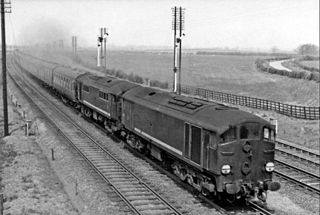
The British Rail Class 28 diesel-electric locomotives, known variously as 'Metrovicks', 'Crossleys' or 'Co-Bos', were built under the Pilot Scheme for diesel locomotives as part of the British Railways 1955 Modernisation Plan.
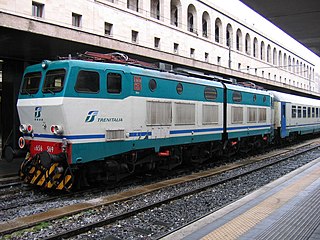
A Bo-Bo-Bo or Bo′Bo′Bo′ is a locomotive with three independent two-axle bogies with all axles powered by separate traction motors. In the AAR system, this is simplified to B-B-B due to the system only taking powered axles into consideration, not traction axles.

Co-Co is the wheel arrangement for diesel and electric locomotives with two six-wheeled bogies with all axles powered, with a separate traction motor per axle. The equivalent UIC classification (Europe) for this arrangement is Co′Co′, or C-C for AAR.
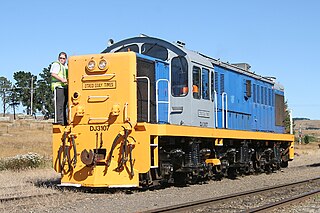
The New Zealand DJ class locomotive is a type of diesel-electric locomotive in service on the New Zealand rail network. The class were built by Mitsubishi Heavy Industries and introduced from 1968 to 1969 for the New Zealand Railways Department (NZR) with a modernisation loan from the World Bank to replace steam locomotives in the South Island, where all of the class members worked most of their lives. Nine of the locomotives remain in use, mainly with Dunedin Railways.

The New Zealand DA class locomotive were a class of diesel-electric mainline locomotives operated on the New Zealand railway system between 1955 and 1989. Consisting of 146 locomotives, it was the most numerous class to ever operate in New Zealand, with five more than the AB class steam locomotive.

Co-Bo or Co′Bo′ is a wheel arrangement in the UIC classification system for railway locomotives. It features two uncoupled bogies. The "Co" bogie has three driven axles and the "Bo" bogie has two.

The EMD G12 is a class of export locomotive built by GM-EMD, and its Canadian affiliate General Motors Diesel. In addition, Australian licensee Clyde Engineering built ten locomotives for New Zealand in 1957, five for Hong Kong, 23 for Queensland, fourteen for Western Australia and seven for BHP. Australian licensee Commonwealth Engineering also built 42 for Queensland Rail in 1964–1966. Many examples were built in the 1950-1960s for railroads around the world.

The New South Wales 42 class was a class of diesel locomotives built by Clyde Engineering, Granville for the New South Wales Department of Railways in 1955/56.

The 49 class are a class of diesel locomotives built by Clyde Engineering, Granville for the New South Wales Department of Railways between 1960 and 1964.

The EMD G16 is a diesel locomotive built by General Motors in the US and under licence by Clyde Engineering in Australia and MACOSA in Spain. It has been used in Australia, Brazil, Egyptian Railways, Hong Kong, Israel Railways, Mexico, Spain, Yugoslav Railways and on the successor Croatian Railways, Slovenian Railways, Serbian Railways, Macedonian Railways, Republika Srpska Railways, Kosovo Railways and Railways of the Federation of Bosnia and Herzegovina.

The P class are a class of diesel locomotives rebuilt from T class locomotives by Clyde Engineering, Somerton for V/Line in 1984–1985.
Aurizon electric locomotives are used by Australian rail operator Aurizon in Queensland.

The 1450 class was a class of diesel locomotive built by Clyde Engineering, Granville for Queensland Railways in 1957-1958.
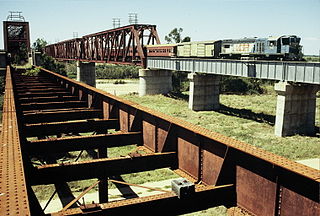
The 1460 class was a class of diesel locomotives built by Clyde Engineering, Eagle Farm for Queensland Railways between 1964 and 1966.
The 1700 class was a class of diesel locomotives built by Clyde Engineering, Eagle Farm for Queensland Railways in 1963.
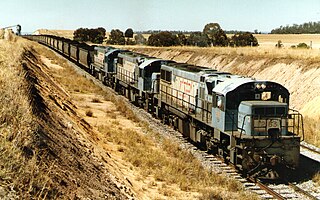
The 2150 class was a class of diesel locomotives built by Clyde Engineering, Eagle Farm for Queensland Railways in 1978–1979.